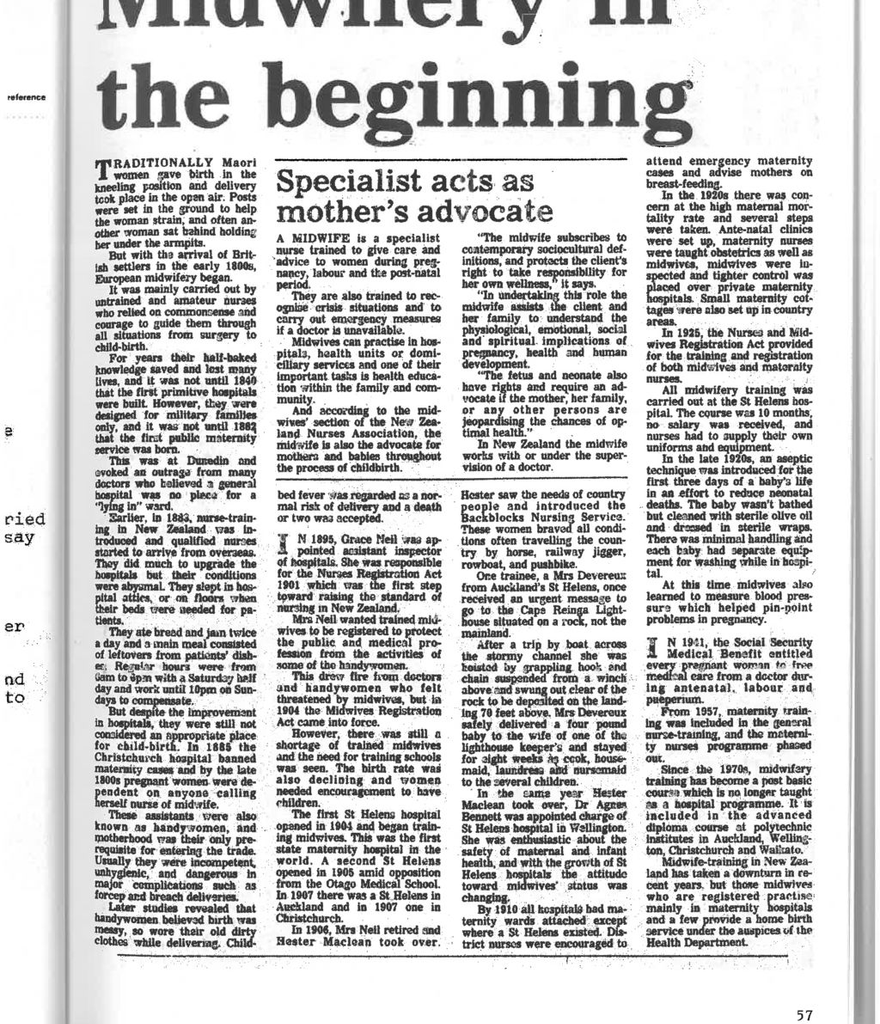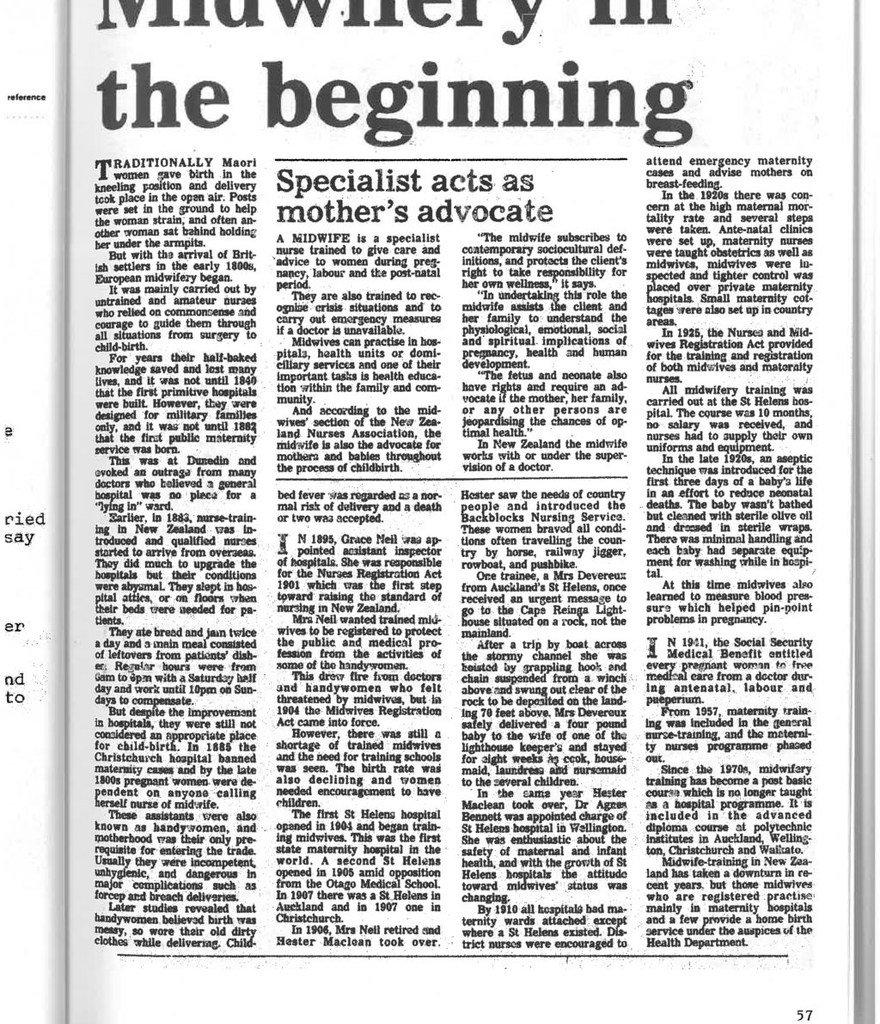Foxton Maternity Home 1942-1982 Page 57
- Description
TRADITIONALLY Maori women gave birth in the kneeling position and delivery took place in the open air. Posts were set in the ground to help the woman strain; and often an-other woman sat behind holding her under the armpits.But with the arrival of British settlers in the early 1800s, European midwifery began.
It was mainly carried out by untrained and amateur nurses who relied on commonmnse and courage to guide them through all situations from surgery to child-birth.
For years their half-baked knowledge saved and lost many lives, and it was not until 1840 that the first primitive hospitals were built However, they were designed for Military families only, and it was not until 1882 that the first public maternity service was born.
This was at Dunedin and evoked an outrage from many doctors who believed a general hospital was no place: for a "lying-in" ward.
Earlier, in 1883. nurse-train-ing in New Zealand was introduced and qualified nurses started to arrive from overseas. They did much to upgrade the hospitals but their conditions were abysmal. They slept in hospital attics, or on floors when their beds were needed for patients.
They ate bread and jam twice a day and a main meal consisted of leftovers from patients dishes. Regular hours were from 6am to 6pm with a Saturday half day and work until 10pm on Sundays to compensate.
But despite the Improvement in hospitals, they were still not considered an appropriate place for child-birth. In 1885 the Christchurch hospital banned maternity cases and by the late 1800s pregnant women were dependent on anyone calling herself nurse or midwife.
These assistants were also known as handywomen, and motherhood was their only prerequisite for entering the trade. Usually they were incompetent, unhygienic, and dangerous in major complications such as forcept and breach deliveries.
Later studies revealed that handywomen believed birth was messy, so wore their old clothes while delivering. Childbed fever
Specialist acts as mother's advocate
A MIDWIFE is a specialist nurse trained to give care end 'dvice to women during pregnancy, labour and the post-natal period.They are also trained to recognise crisis situations and to carry out emergency measures if a doctor is unavailable.
Midwives can practise in hospitals, health units or domiciliary services and one of their important tasks is health education within the family and community.
And according to the midwives' section of the New Zealand Nurses Association, the Midwife is also the advocate for mothers and babies throughout the process of childbirth.
'The midwife subscribes to contemporary sociocultural definitions, and protects the clientis right to take responsibility for her own wellness," it says.
"In undertaking this role the midwife assists the client and her family to understand the physiological, emotional, social and spiritual implications of pregnancy, health and human development.
"The fetus and neonate also have rights and require an advocate if the mother, her family, or any other persons are jeopardising the chances of optimal health."
In New Zealand the midwife works with or under the supervision of a doctor.
bed fever as regarded as a normal risk of delivery and a death or two was accepted.In 1895, Grace Neil was appointed assistant inspector of hospitals. She was responsible for the Nurses Registration Act 1901 which was the first step toward raising the standard of nursing in New Zealand.
Mrs Neil wanted trained wives to be registered to protect the public and medical profession from the activities of some of the handywomen.
This drew fire from doctors and handywomen who felt threatened by midwives, but in 1904 the Midwives Registration Act came into force.
However, there was still a shortage of trained midwives and the need for training schools was seen. The birth rate Wad also declining and women needed encouragement to have children.
The first St Helens hospital opened in 1904 and began training midwives. This was the first state maternity hospital in the world. A second at Helens opened in 1905 amid opposition from the Otago Medical School. In 1907 there was a St Helens in Auckland and in 1907 one in Christchurch.
In 1906, Mrs Neil retired and Heater Maclean took over. Heather saw the needs of country people and introduced the Backblocks Nursing Service. These women braved all conditions often travelling the country by horse, railway jigger, rowboat, and pushbike.
One trainee, a Mrs Devereux from Auckland's St Helens, once received an urgent messes, to go to the Cape Reinga Lighthouse situated on a rock, not the mainland.
After a trip by boat across the stormy channel she was hoisted by grappling hook and chain suspended from a winch above and swung out clear of the rock to be deposited on the landing 70 feet above. Mrs Dovetail safely delivered a four pound baby to the wife of one of the lighthouse keeper's and stayed for eight weeks as cook, housemaid, laundress and nursemaid to the several children.
In the same year Hester Maclean took over, Dr Agnes Bennett was appointed charge of St Helens in Wellington. She was enthusiastic about the safety of maternal and infant health, and with the growth of St Helens hostitals the attitude toward midwives' status was changing.
By 1910 all hospitals had maternity wards attached except where a St Helens existed. District nurses were encouraged to attend emergency maternity cases and advise mothers on breast-feeding.
In the. 1920s there was concern at the high maternal mortality rate and several steps were taken. Ante-natal clinics were set up, maternity nurses were taught obstetrics as well as midwives, midwives were inspected and tighter control was placed over private maternity hospitals. Small maternity cottages were set up in country areas.
In 1925, the Nurises and Midwives Registration Act provided for the training and registration of both midwives and maternity nurses.
All midwifery training was carried out at the St Helens hospital, The course was 10 months, no salary was received, and nurses had to supply their own uniforms and equipment.
In the late 1920s, an aseptic technique was introdueed. for the first three days of a baby's life in as effort to reduce neonatal deaths. The baby wasn't bathed but cleaned with sterile olive oil and dressed in sterile wraps. There was minimal handling and each baby had separate equipment for washing while in hospital.
At this time midwives also learned to measure blood pressure which helped pin-point problems in pregnancy.
In 1941, the Social Security Medical Benefit entitled every pregnant woman to free medical care from a doctor during antenatal, labour and pueperium.
From 1957, maternity training was included in the general nurse-training, and the maternity nurses programme phased out.
Since the 1970s, midwifery training has become a post basic course which is no longer taught as a hospital programme. It is included in the advanced diploma course at polytechnic institutes in Auckland, Wellington, Christchurch and Waikato.
Midwife-training in New Zealand has taken a downturn in recent years but those midwives who are registered practice mainly in maternity hospitals and a few provide a home birth service under the auspices of the Health Department.
Identification
- Date
- unknown
Taxonomy
- Community Tags


